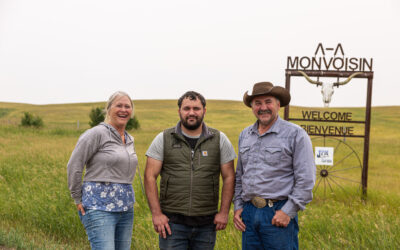
Stocker pre-grass management that pays
March 29, 2011
One of the best things about a ranch field day, except maybe the “conference room” view, is getting a chance to see the inner workings of another guy’s ranch. It’s one thing to garner ideas; it’s another to see them in action.
Last week we were out at the Collinge Ranch in Hamilton, Kan., where owner Mike Collinge couldn’t have said it better: “I can’t claim to have had a lot of great original ideas,” he joked, “but I can claim to being smart enough to steal a few good ones from other people! I hope we can share a few more with each other today.”
That open attitude toward information exchange was one reason we asked Mike to host the Backgrounding for Quality field day at his ranch. We also knew he was a stocker operatory with some great pre-grass management strategies to share. Most of those strategies revolve around his team’s handling practices.
- “We like to move them through the system as often as possible. I really believe that how we handle them here will affect how they perform after we gather them off grass. Feedback from the feedyards say this systems pays off big time for them.”
- Day one: Within 24 hours of arrival, they run calves through the processing facilities, administer the first round of vaccines and record temperature readings. “I’ve yet to find anything as effective as temperature to really measure a calf’s health,” Mike said.
- Day 5-7: Run calves through processing facilities again; record temperatures and treat with antibiodics if necessary. “We like to play offense, not defense on animal health. You can never catch up if you’re playing defense,” Mike explained. “Monitoring and recording temperatures indicate health issues long before they start showing physical signs.”
- Day 10-11: Run calves through processing facilities; administer second round of viral shots and record temperatures. Read a few tips on properly measuring temperatures here.
- Every day before being turned out to summer pasture: Lot loads are kept in separate grass traps and brought in one at a time once a day. That first two,three weeks is a critical time to get the calves proper nutrition to get them ready to be on their own for grazing. “Copper, zinc and selenium are incredibly important parts of a starter ration when it comes to the health of these calves,” he said.
After feeding, the group is kicked back out to pasture and the next group is brought in. The feeding crew monitors calves as they come in the feed pen. If they spot a calf that looks sick at the end of the group, they’ll separate the tail end and bring five to 10 calves in to have their temperatures checked and monitored. Not only is this less stressful on the calves, Mike explained, but it’s also a good indication of the health of the rest of the herd.
Calves that are slow to the feedbunk and are hanging around others already showing physical signs of illness are the most likely candidates for illness. “You might find one or two in that group that are running a temperature besides the one that looked sick,” Mike said. “You can get ahead of that illness and treat them before it becomes a problem.”
But if you find five or six calves running a temperature in the group, it’s a good indication that the entire group needs re-checked for health problems. “We get a lot more performance out of those calves because health issues are addressed sooner.”
“There is no time difference between running a whole set of calves through the chute compared to pulling five to 10 calves all the time,” Mike said. Case and point: before implementing this handling system, he said it was common to have to pull and treat up to 60% of any given lot. Now, after catching the sick ones in the chutes, they pull less than 10% for health treatment.
Of course, that reduces labor, stress and costs for Mike and his crew, but there’s a greater reason: “We hope that these things are having an impact on carcass quality and performance. The goal is to create cattle that will do better down the line,” he says. That’s a management attitude that pays for cattlemen and consumers.
You may also like
Saskatchewan Angus Ranch Earns Certified Angus Beef Award
JPM Farms in Canada quietly gained recognition for its dedication to environmental sustainability and quality cattle. The Monvoisin family earned the 2023 CAB Canadian Commitment to Excellence award for their outstanding results and partnership with Duck Unlimited, showcasing their commitment to improving the land, cattle and family daily.
Everything They Have
Progress is a necessity on the Guide Rock, Nebraska, ranch where Troy Anderson manages a commercial Angus herd, small grower yard, his 10-year-old son, and a testing environment. Troy’s approach includes respect for his livestock, people and land. For that, Anderson Cattle was honored with the CAB 2023 Commercial Commitment to Excellence Award.
Excellence by Everyday Improvement
The cattle business awards no trophies for participation. Nor does any rancher plan and work each day in hopes of wider recognition for doing things right. Yet caring for their land and livestock with a daily devotion to “excellence in practice” quietly switched a spotlight on JPM Farms. Jean-Paul and Marlene Monvoisin with their adult children, Colton Monvoisin and Josee Monvoisin-Garner, operate the quality-focused seedstock Angus ranch in the rolling hills near Parkbeg, Saskatchewan.



